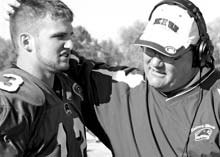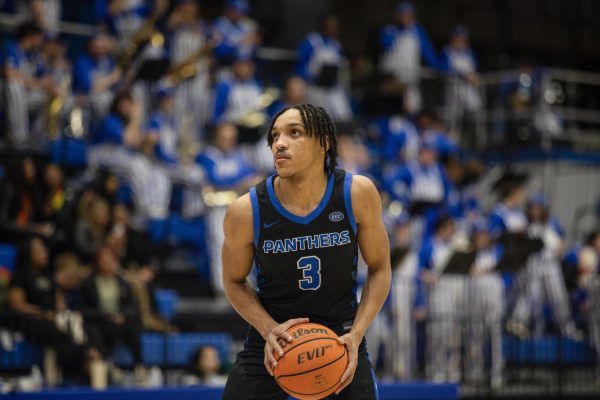Second chance in Charleston
On Oct. 7 Cole Stinson and Micah Rucker hooked up for three touchdowns.
The pair, who played together at Dunbar High School in Estero, Fla., had something else in common besides their alma mater.
Both came to Eastern before the season from I-A programs and, before a Family Weekend crowd, showed how valuable transfers can be.
Stinson, a Ball State transfer, started the last eight games of the season for the Panthers and threw for 1, 270 yards and 12 touchdowns and led Eastern back to the I-AA playoffs.
When Stinson transferred he didn’t expect I-AA football would be as competitive as it was.
“The transition was different than I thought,” Stinson said. “The playing level was still high and the intensity and desire were still very high.”
Rucker, a 6-foot-6 wide receiver from the University of Minnesota, was named first team all-Ohio Valley Conference in his first season at Eastern after catching 49 passes for 966 yards and 13 touchdowns.
This season, there were 11 transfers on Eastern’s roster and six more just arrived.
Tim Gritzman, a former walk-on tight end at Notre Dame, joined three Bowling Green transfers – offensive linemen Guy Williamson and Kevin Mahoney and defensive lineman Trevor Frericks – in Charleston this semester.
Two community college transfers also arrived at Eastern last week.
James Jones, a cornerback from Ellsworth Community College in Iowa Falls, Iowa, made 63 tackles last season and returned his lone interception 100 yards for a touchdown.
Another junior college transfer, wide receiver Garrett Clark, had a team high 27 catches for 336 yards and two touchdowns last season for Hutchinson Community College in Hutchinson, Kan.
Williamson, Mahoney and Jones will be able to compete for positions on the offensive line and secondary that graduated six out of nine starters.
While Rucker and Stinson were able to contribute right away, not all transfers make an immediate mark.
Junior running back Lawrence Cannon, a transfer from Western Michigan, did not see the field this season and Bodie Reeder, a sophomore quarterback that transferred from Wyoming, also did not get any playing time.
Matt Dougherty, I-AA football editor for The Sports Network, said transfers “aren’t always slam dunks” and usually the players that had some success in I-A have the best careers after transferring.
While the influx of big-school talent can be tempting, Dougherty said, coaches tend to shy away from relying on transfers to build their program.
“Usually coaches look for two or three guys who can come in, play right away, and fill a couple holes,” Dougherty said. “But they want to build their programs around 4-year guys.”
The ability to play right away is the biggest draw to transfer to a I-AA school like Eastern.
According to NCAA transfer rules, a player that has taken at least 12 credits per semester and is in good academic standing at his previous school, can transfer from a I-A program to a I-AA school without sitting out a year.
Switching from a I-A school to another I-A team requires “a year of residence” at the transfers’ new school as a full-time student before he can play or practice with his new team, according to the NCAA’s Transfer 101 guidebook.
There are many different reasons that players decide to transfer.
Dougherty said the desire for more playing time is the most common reason players switch schools. But Stinson added that the ever-changing coaching staffs in college football are also behind many transfers.
“Sometimes new coaches bring in their own players or change the system,” Stinson said. “Players didn’t adapt to new coaches and coaches didn’t adapt to players. Sometimes things just don’t work out.”
Second chance in Charleston

Acting head coach Mark Hutson discusses the game plan with junior quarter back Cole Stinson during the homecomming game last Saturday at O’Brien stadium. (Jay Grabiec/The Daily Eastern News)


















![[Thumbnail Edition] Senior Foward Macy McGlone, getsw the ball and gets the point during the first half of the game aginst Western Illinois University,, Eastern Illinois University Lost to Western Illinois University Thursday March 6 20205, 78-75 EIU lost making it the end of their season](https://www.dailyeasternnews.com/wp-content/uploads/2025/03/WBB_OVC_03_O-1-e1743361637111-1200x614.jpg)

















































